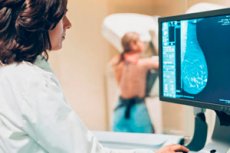
18 May 2024, 10:25
根据 5 月 5 日至 9 日在波士顿举行的美国放射学会 (ARRS) 年会上公布的研究,筛查乳房 X 光检查中脂肪增大的腋窝淋巴结可能预测心血管疾病 (CVD)风险。
美国新罕布什尔州黎巴嫩达特茅斯-希区柯克医疗中心的医学博士杰西卡·鲁比诺 (Jessica Rubino) 及其同事使用了 907 名女性(年龄 40 至 75 岁)的电子医疗记录数据,这些女性没有已知的冠心病,接受常规乳房X 线检查,并且在指数乳房 X 线检查后一年内(2011-2012 年)存在心血管危险因素。
研究人员发现,19.1% 的女性患有脂肪性肿大结节(由于脂肪窦扩张,长度 > 20 毫米)。根据汇总队列方程,患有脂肪性肿大结节的女性心血管疾病 (CVD) 风险较高(10 年内发生主要不良心血管事件 [MACE] 的几率 > 7.5%;比值比 [OR] 2.6;95% 置信区间 [CI] 1.5 至 4.2),且2 型糖尿病(OR 4.0;95% CI 2.1 至 7.7) 和高血压 (OR 2.5;95% CI 1.6 至 4.0) 的患病率也较高。
研究还发现脂肪增大结节与 MACE 风险增高趋势(OR 1.7;95% CI 0.9 至 3.1)和低密度脂蛋白胆固醇水平(OR 1.4;95% CI 0.9 至 2.1)之间存在关联。
鲁比诺在一份声明中表示:“将脂肪增大结节整合到心血管疾病风险模型中,有可能改善心血管疾病风险分层,而无需额外的成本或额外的测试。”
“乳房 X 线摄影筛查中可见的脂肪性腋窝淋巴结肿大可能有助于识别可能受益于心血管疾病风险降低策略和冠状动脉 CT 更深入风险评估的女性。”

